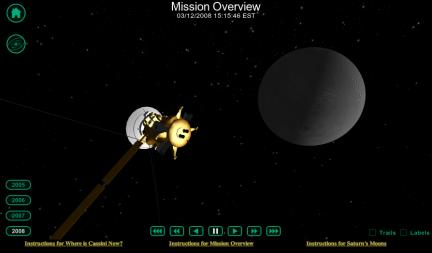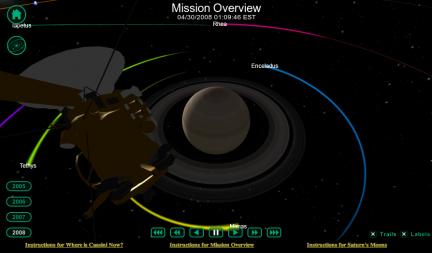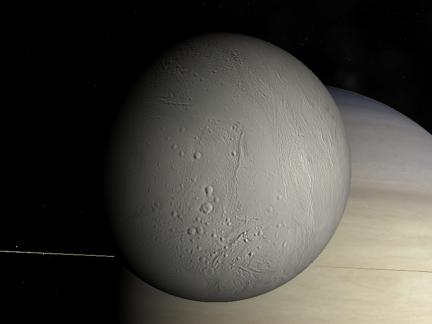 Go over and check out the interactive Cassini simulator at saturn.jpl.nasa.gov. Shown above is the simulator’s view of Cassini’s upcoming Enceladus flyby. Scale at this view is not terribly accurate as when you spin the view around — it will seem as if the spacecraft is the same size as the moon. However, it is pretty cool watching the mission in high speed with the labels and orbit trails turned on as seen below.
Go over and check out the interactive Cassini simulator at saturn.jpl.nasa.gov. Shown above is the simulator’s view of Cassini’s upcoming Enceladus flyby. Scale at this view is not terribly accurate as when you spin the view around — it will seem as if the spacecraft is the same size as the moon. However, it is pretty cool watching the mission in high speed with the labels and orbit trails turned on as seen below.
You will probably have to install a plug-in to use this, but it is quite simple. It should take care of itself for PC users, for MAC users you only need to download the installer and execute the installation from wherever your downloaded files reside. Some platforms may require restarting the browser should the plug-in appear to not be working after installation.
If this isn’t impressive enough for you and you want to go hard-core, try downloading CELESTIA. This is an application based simulator of our galaxy that is supported by a community of users which expand the program’s capabilities by keeping the surface maps of all the planets and moons up to date. There are even mission simulators you can download and ride shotgun along with historic missions such as Voyager and many others. Even more impressive is flying to other star systems where astronomers have discovered exo-planets and discovering that someone has already added a hypothetical model of that new world to the data set. A fair warning is in order — installing this is and then expanding the program through use of the Celestia Motherlode may result in hours worth of unproductive time.
Here is what an Enceladus flyby looks like in Celestia with updated skins. This is an actual screengrab from the application.

